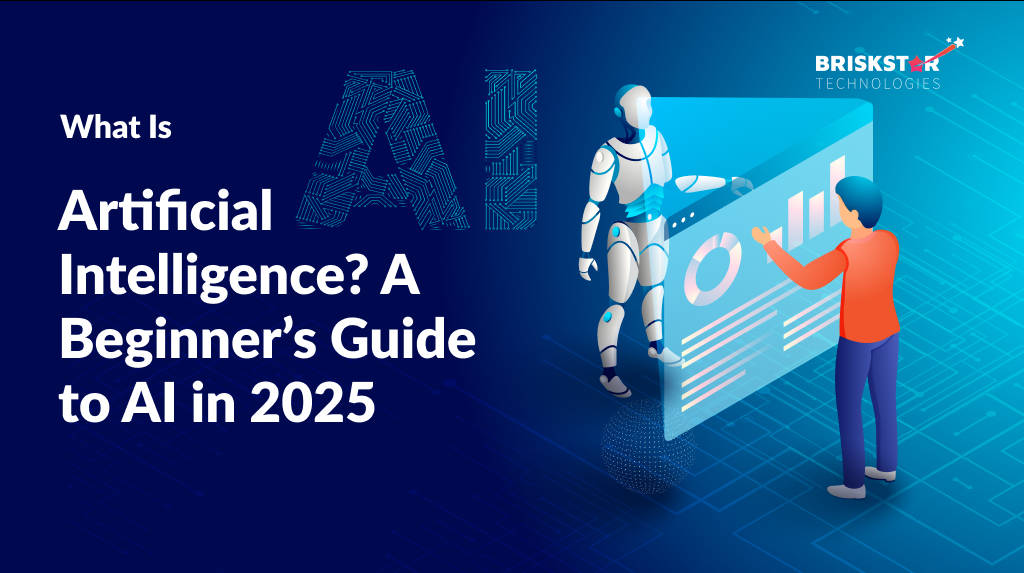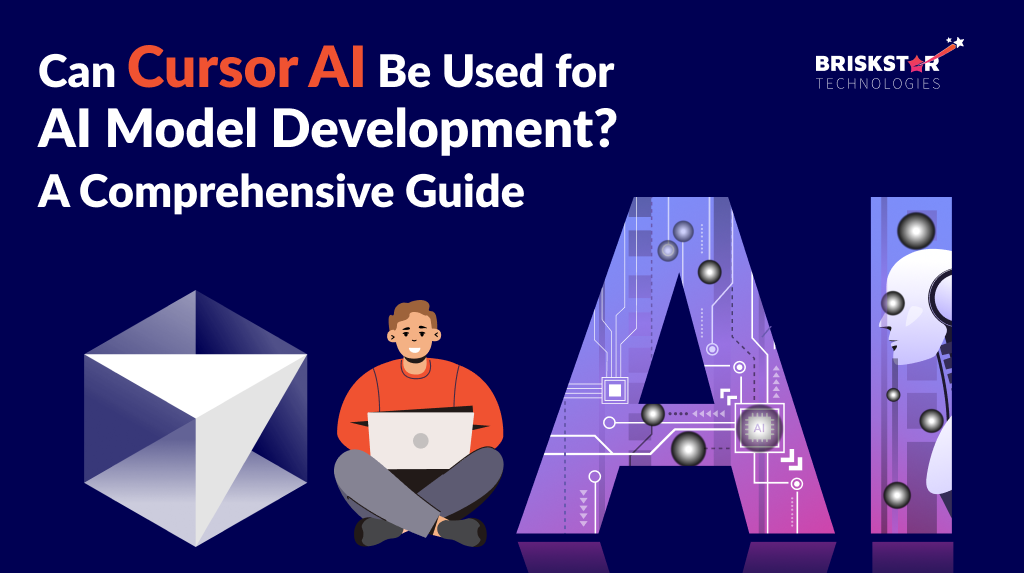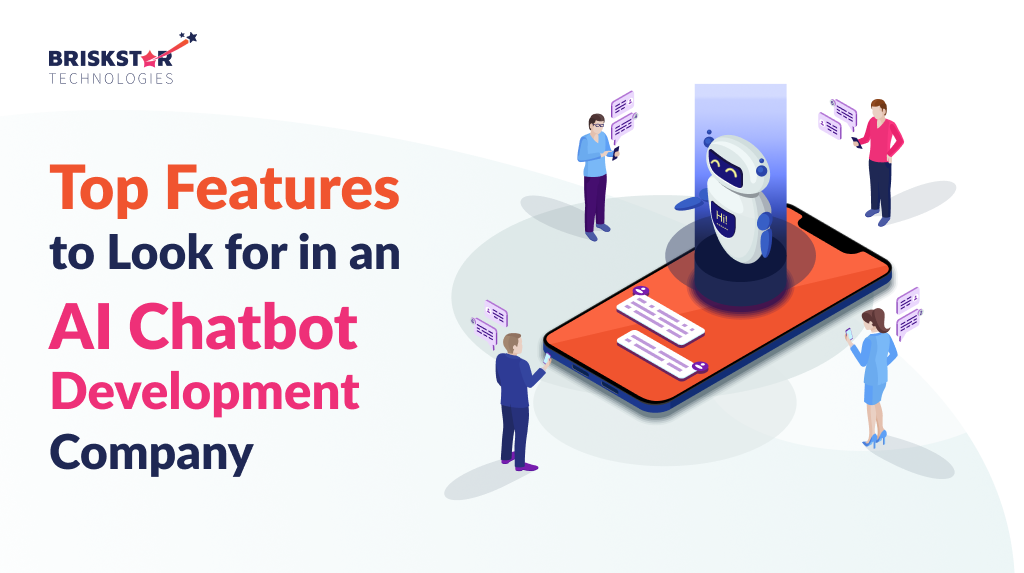What Is Artificial Intelligence? A Beginner’s Guide to AI in 2025
Artificial Intelligence (AI) is no longer a futuristic concept, it’s the foundation of modern innovation. From smart assistants like Siri and Alexa to self-driving cars and advanced data analytics, AI is transforming how we live, work, and communicate.
In this beginner’s guide to Artificial Intelligence in 2025, we’ll explore what AI really is, how it works, its core technologies, and why it has become one of the most powerful forces driving digital transformation.
Understanding Artificial Intelligence (AI)
What Is Artificial Intelligence?
Artificial Intelligence is the branch of computer science that enables machines to simulate human intelligence—allowing them to think, learn, and make decisions. In simple terms, AI is about creating systems that can perform tasks that typically require human intelligence such as:
The goal of AI is to create machines that can perceive, reason, and act intelligently, improving over time with experience and data.
The Evolution of AI: From Concept to Reality
AI’s journey began decades ago, but the real revolution started in the 21st century with the rise of big data, machine learning, and cloud computing.
Key milestones in AI history:
-
1950s: Alan Turing introduced the concept of intelligent machines through the Turing Test.
-
1980s: Expert systems became popular for solving domain-specific problems.
-
2000s: Machine Learning (ML) and Deep Learning (DL) transformed AI capabilities.
-
2020s: AI became mainstream, powering automation, healthcare, and autonomous systems.
In 2025, AI continues to evolve rapidly with the integration of Generative AI, Edge AI, and Quantum Computing.
How Does Artificial Intelligence Work?
AI systems work by combining data, algorithms, and computing power to mimic human cognitive functions.
Core Components of AI:
-
Data Collection: AI learns from large datasets, identifying patterns and relationships.
-
Algorithms: Mathematical models that process data and generate insights.
-
Training: Using techniques like supervised and unsupervised learning to improve accuracy.
-
Inference: Applying learned knowledge to make predictions or decisions.
AI models are trained through neural networks, which simulate how the human brain processes information.
Major Branches of Artificial Intelligence
AI is not a single technology, it’s an umbrella term covering various subfields. Understanding these branches helps you grasp how AI powers different industries.
Machine Learning (ML)
Machine Learning enables systems to learn automatically from data without being explicitly programmed. It’s used in recommendation systems, fraud detection, and predictive analytics.
Types of Machine Learning:
-
Supervised Learning: Learns from labeled data (e.g., spam detection).
-
Unsupervised Learning: Identifies hidden patterns (e.g., customer segmentation).
-
Reinforcement Learning: Learns from trial and error (e.g., robotics, gaming).
Deep Learning (DL)
Deep Learning is a subset of ML that uses artificial neural networks to process complex data like images, voice, and text.
It powers technologies like facial recognition, autonomous vehicles, and speech assistants.
Natural Language Processing (NLP)
NLP helps computers understand and generate human language. It is the foundation of chatbots, voice assistants, and translation apps.
Applications of NLP:
-
Sentiment analysis
-
Language translation
-
Text summarization
-
Speech recognition
Computer Vision
Computer Vision enables machines to interpret and understand visual data such as images and videos.
Examples include facial recognition, medical imaging, and autonomous driving systems.
Robotics
AI-driven robotics combines mechanical engineering with AI algorithms, allowing robots to perform tasks autonomously, from warehouse automation to surgical operations.
Real-World Applications of Artificial Intelligence
AI is already embedded in almost every aspect of modern life.
Top AI Applications in 2025:
-
Healthcare: AI diagnoses diseases, analyzes scans, and personalizes treatment plans.
-
Finance: Detects fraud, predicts market trends, and automates trading.
-
Education: Delivers adaptive learning and smart tutoring systems.
-
Retail: Enhances customer experience through AI chatbots and recommendation engines.
-
Manufacturing: Predictive maintenance and quality control through AI vision systems.
-
Marketing: Automates campaigns, analyzes sentiment, and improves customer targeting.
AI’s power lies in its ability to process massive data sets in real time, helping businesses make smarter, faster decisions.
Benefits of Artificial Intelligence
AI delivers countless advantages that are revolutionizing industries worldwide.
Key Benefits:
-
Automation of repetitive tasks
-
Data-driven decision-making
-
Enhanced accuracy and efficiency
-
Personalized customer experiences
-
Cost reduction and time savings
-
Real-time analytics and forecasting
By 2025, AI has become a core driver of digital transformation across every business sector.
Challenges and Ethical Concerns of AI
While AI offers immense potential, it also raises ethical, technical, and social challenges.
Main Concerns Include:
-
Data Privacy: Ensuring user information is protected.
-
Bias in Algorithms: Preventing unfair or discriminatory outcomes.
-
Job Displacement: Automation may replace certain roles.
-
AI Misuse: Deepfakes and misinformation risks.
To ensure responsible innovation, companies must adopt ethical AI frameworks, transparency, and human oversight.
The Future of Artificial Intelligence in 2025 and Beyond
The future of AI is defined by smarter algorithms, greater autonomy, and deeper integration into everyday life.
Emerging AI Trends for 2025:
-
Generative AI: Tools like ChatGPT and Midjourney are reshaping creativity.
-
Edge AI: Processing data locally on devices for faster performance.
-
AI in Cybersecurity: Predicting and preventing digital threats.
-
Quantum AI: Using quantum computing for faster, complex problem-solving.
-
Sustainable AI: Eco-friendly and energy-efficient AI models.
By 2030, AI will become a trillion-dollar industry, impacting every sector from healthcare to space exploration.
9. Getting Started with AI: A Beginner’s Roadmap
If you’re new to AI, the learning curve can seem steep, but it’s easier than you think.
Steps to Start Your AI Journey:
-
Learn the basics of Python and data science.
-
Understand core AI concepts—ML, NLP, Deep Learning.
-
Use beginner-friendly AI tools like TensorFlow, PyTorch, and Google AI Studio.
-
Build small projects such as chatbots or sentiment analyzers.
-
Stay updated with AI news, communities, and research.
With time and practice, you can build your own AI models and applications, a skill in high demand globally.
Conclusion
Artificial Intelligence has moved beyond buzzword status it’s shaping the digital world in real time. From smarter healthcare to personalized shopping, AI is transforming every aspect of modern life.
As we enter 2025, understanding AI is no longer optional it’s essential for individuals and businesses alike. Whether you’re a developer, entrepreneur, or curious learner, exploring AI will help you unlock new opportunities and stay ahead in a rapidly evolving world.
Frequently Asked Questions About Our Blog
Artificial Intelligence is the ability of machines to mimic human intelligence learning from data and making decisions without human input.
AI is categorized into narrow AI, general AI, and super AI, based on how capable and autonomous the system is.
No. Machine Learning is a subset of AI that focuses on learning from data, while AI encompasses broader intelligence capabilities.
Examples include chatbots, recommendation engines, voice assistants, and fraud detection systems.
AI will continue to evolve with innovations in Generative AI, Edge Computing, and Quantum AI, driving global automation and creativity.
![circle-shapes]()










